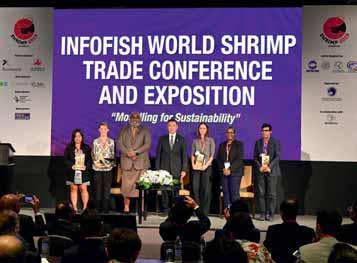
3 minute read
INFOFISH World Shrimp Trade Conference and Exposition, November 2019, Bangkok
by Eurofish
Sustainability hinges on main players’ convictions
Advertisement
Sustainability is moving ever higher up the agenda of the global fisheries and aquaculture sector driven partly by NGOs in the major seafood markets of the world who are effective at shaping consumer opinion. Acknowledging this development, the INFOFISH World Shrimp Trade Conference and Exposition chose sustainability as the main theme of this event.
The event was opened by Mr Semi Koroilavesau, Minister for Fisheries of Fiji who likened aquaculture to a silver bullet that could solve many of the issues currently besetting countries. During the session, Mr Thaworn Jirasoponrak, Deputy Director General, Department of Fisheries, Thailand said that sustainability in the Thai shrimp sector was contingent upon better cooperation between all the sectors in the industry and upon traceability. Other speakers suggested that Asian shrimp aquaculture should emphasise farm protocols rather than intensification of culture to achieve meaningful sustainability. For example, India will launch its antibiotic-free farmed shrimp certification programme from 2020 which will be based on Best Management Practices (BMP).
Better farm management techniques can contribute to a more sustainable industry
In Bangladesh, the National Action Plan aims to establish 20 specific pathogen free (SPF) P. monodon hatcheries and to promote improved culture practices. Saudi Arabia has established the world’s largest single bio secure recirculation aquaculture facility and is targeting a production of 200,000 tonnes by 2025. The Ecuadorian shrimp industry achieved recognition for sustainability through its Sustainable Shrimp Partnership (SSP) launched in 2017 with the help of WWF, the Sustainable Trade Initiative from the Netherlands, and the Aquaculture Stewardship Council. Speakers also reported that adapted rearing protocols, quality diets, the application of health enhancers and improved pathogen detection techniques like Shrimp Multipath, a technology from an Australian company, would increase production efficiency in the future.
In the second session, speakers focused on consumer demand, markets and trade. The value of retail-sold shrimp in the US has risen by 9 while volume has grown by 37 over 2018. China has emerged as the second largest shrimp importer, overtaking the US in the global shrimp trade in the first six months of 2019. In Europe, prices, transparency, and product integrity drive the market, while Latin American shrimp exports have doubled over the last five years, and Ecuador has become the world’s second largest shrimp exporter.
Technology is becoming critical to efficient operations all along the value chain
Speakers at the opening session of SHRIMP 2019, an INFOFISH-organised conference focused on making the shrimp industry more sustainable.
sustainable shrimp farming, diagnostics and disease were highlighted in the trends in technology and culture session. Functional diets, prophylaxis and fermented feed will have good potential in future disease management. New testing kits that can provide result within 2.5 hours (as opposed to days) are highly useful in pathogen detection. Artificial Intelligence (AI) will continue to add value to aquaculture as data can be collected in real time, and analysed to forecast diseases, reduce feed costs and predicts market prices. Regarding shrimp broodstock, experts said that often shrimp broodstock marketed as specific pathogen resistant (SPR) was actually specific pathogen tolerant (SPT) and that genuine SPF status guarantees freedom from pathogens. Disease experts forecast that shrimp farming in future will be science based, controlled, and sustainable. According to them efficient biosecurity is the most effective way to prevent pathogens entering into the system.
Shrimp 2019 concluded with the hope of that the shrimp industry would become increasingly sustainable, however, participants also recognised that this was an enormous task and one that would be impossible to achieve without the active participation of the key players.










